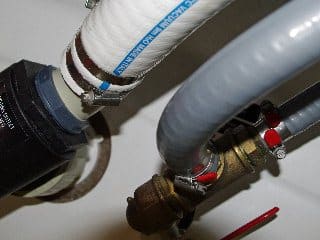
in and out thruhull_3094.jpg
Well, my Say Yes to Seacock Labels post ( http://www.edsboattips.com/maintenance-a-diy/193-say-yes-to-sea-cock-labels ) earlier this week got an almost immediate response from one of our readers. Karl wrote:
“Looking at that photo, there are three (or, possibly four) seacocks with their own thru-hulls…all within inches of each other.
I would think best-practice would be a single thru-hull, terminating with a seacock manifold. Why have so many hull penetrations within inches of each other, when all have the potential to fail? I’m naturally paranoid of below-waterline hull penetrations, and believe they should be consolidated. Just my opinion, but what do I know?
Labels are the least of the problem.” So here’s another photo that might help to explain my answer to Karl, at least in part.

What is being shown above are two through-hull fittings that supply a marine head system. Now you will notice that at least in part the builder applied some of Karl’s thinking here. The through-hull fitting on the right is supplying two water inlets, as I recall feeding two marine head systems. The larger diameter hose on the left is an outlet from a marine holding tank to facilitate overboard discharge in an offshore scenario where it would be legal. The point I’m making is that designers can’t apply Karl’s single fitting approach as easily as he may think. We have inlets and outlets that simply must be separated.
Back to Karl’s thoughts though, could we have all the inlets fed by one seacock and all the overboard discharges taken care of from just one more seacock? Perhaps with a manifold for inlets and one for outlets. I’m certain we could design such a configuration but I suspect that since boat builders are trying to use off-the- shelf, readily available components for these systems to minimize cost, it is unlikely that we’ll see a set-up like Karl wants on production boats any time soon.
I’m of the thinking that just getting the builders to “bundle” all of the seacocks into one area, much like the big boat “sea chest” arrangement where all the seacocks and through-hull fittings are in one box or place on board is a major step forward. This approach by the way, adds cost due to the additional hose required to route everything to one place. I’m sticking to my thoughts in my earlier post, labels are nice.







